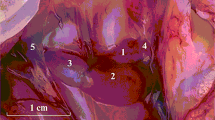Summary
-
1.
The scallopChlamys opercularis uses jet propulsion swimming as a means of escape if attacked by the star fishMarthasterias glacialis. The energy for these rapid movements is supplied by the depletion of the phosphagen phospho-L-arginine. During escape swimming the energy charge of the adductor muscle drops from 0.93 to 0.42. Due to the decrease of phospho-L-arginine from 20.4 to 1.5 μmol/g fresh wt there is a concomitant increase of L-arginine from 14.7 to 34.7 μmol/g fresh wt. No octopine, D- or L-lactate was accumulated in exhausted animals.
-
2.
During the first 30 min of recovery in aerated sea water, octopine, instead of lactate, is synthesized in adductor muscles. The energy charge rises to 0.92. Within 60 min the phospho-L-arginine pool is replenished and half of the accumulated octopine again metabolized.
-
3.
During anaerobic revovery, i.e. when the scallops are kept exposed to air, octopine synthesis is pronounced (7.5 μmol/g fresh wt/h). The energy charge increases to 0.85. However, under these conditions no phospho-L-arginine is formed.
-
4.
There is no evidence for transport of octopine from the adductor muscle to other tissues.
Similar content being viewed by others
References
Atkinson, D.E.: the energy charge of the adenylate pool as a regulative parameter. Interaction with feedback modifiers. Biochemistry7, 4030–4034 (1968)
Atkinson, D.E., Walton, G.M.: Adenosine triphosphate conservation in metabolic regulation. Rat liver citrate cleavage enzyme. J. biol. Chem.242, 3239–3241 (1967)
Beis, I., Newsholme, E.A.: The contents of adenine nucleotides, phosphagens and some glycolytic intermediates in resting muscles from vertebrates and invertebrates. Biochem. J.152, 23–32 (1975)
Buddenbrock, W.v.: Untersuchungen über die Schwimmbewegungen und Statocysten der Gattung Pecten. Sitzungsber. Heidelberger Akad. Wiss.28, 1–24 (1911)
Buddenbrock, W.v.: Die “fliegenden Kamm-Muscheln”. Umschau59, 124 (1959)
Embden, G., Hirsch-Kauffmann, H., Lenhartz, E., Deuticke, H.J.: Über den Verlauf der Milchsäurebildung beim Tetanus. Hoppe Seylers Z. physiol. Chem.151, 209–231 (1926)
Furia, R.R. de, Kuschmerick, M.J.: ATP utilization associated with recovery metabolism in anaerobic frog muscle Amer. J. Physiol.232, 30–36 (1977)
Grieshaber, M., Gäde, G.: The biological role of octopine in the squid,Loligo vulgaris (Lamarck). J. comp. Physiol.108, 225–232 (1976a)
Grieshaber, M., Gäde, G.: Die biologische Bedeutung des Octopins bei Mollusken. Verh. dtsch. Zool. Ges. 222 (1976b)
Grieshaber, M., Gäde, G.: Energy supply and the formation of octopine in the adductor muscle of the scallopPecten jacobaeus. Comp. Biochem. Physiol.58B, 249–252 (1977)
Grieshaber, M., Kronig, E., Koormann, R.: A photometric estimation of phospho-L-arginine, arginine and octopine using homogenous octopine dehydrogenase isoenzyme 2 from the squid,Loligo vulgaris. Hoppe Seylers Z. physiol. Chem.359, 133–136 (1978)
Gutmann, I., Wahlefeld, W.A.: L-Lactat. Bestimmung mit Lactat-Dehydrogenase und NAD. In: Methoden der enzymatischen Analyse, Bd. 2 (ed. H.U. Bergmeyer), pp. 1510–1514. Weinheim: Verlag Chemie 1974
Hochachka, P.W., Hartline, P.H., Fields, J.H.A.: Octopine as an endproduct of anaerobic glycolysis in the chambered Nautilus. Science195, 72–74 (1977)
Jaworek, D., Gruber, W., Bergmeyer, H.U.: Adenosin-5′-diphosphat und Adenosin-5′-monophosphat. In: Methoden der enzymatischen Analyse, Bd. 2 (ed. H.U. Bergmeyer), pp. 2179–2181. Weinheim: Verlag Chemie 1974
Lamprecht, W., Trautschold, I.: Bestimmung von ATP mit Hexokinase und Glucose-6-phosphat-Dehydrogenase In: Methoden der enzymatischen Analyse, Bd. 2 (ed. H.U. Bergmeyer), pp. 2151–2159. Weinheim: Verlag Chemie 1974
Lundsgaard, E.: Über die Energetik der anaeroben Muskelkontraktion. Biochem. Z.233, 322–343 (1931)
Moore, J.D., Trueman, E.R.: Swimming of the scallopChlamys opercularis (L.). J. exp. mar. Biol. Ecol.6, 179–185 (1971)
Regnouf, F., Thoai, v.N.: Octopine and lactate dehydrogenases in molluse muscles. Comp. Biochem. Physiol.32, 411–416 (1970)
Thoai, v.N., Robin, Y.: Sur la biogenese de l'octopine dans différents tissus dePecten maximus L. Bull. Soc. Chim. Biol.41, 735–742 (1959)
Yonge, C.M.: The evolution of the swimming habit in the Lamellibranchia. Mém. Mus. r. Hist. nat. Belg., 2mc Sér.3, 77–100 (1956)
Author information
Authors and Affiliations
Rights and permissions
About this article
Cite this article
Grieshaber, M. Breakdown and formation of high-energy phosphates and octopine in the adductor muscle of the scallop,Chlamys opercularis (L.), during escape swimming and recovery. J Comp Physiol B 126, 269–276 (1978). https://doi.org/10.1007/BF00688937
Accepted:
Issue Date:
DOI: https://doi.org/10.1007/BF00688937




